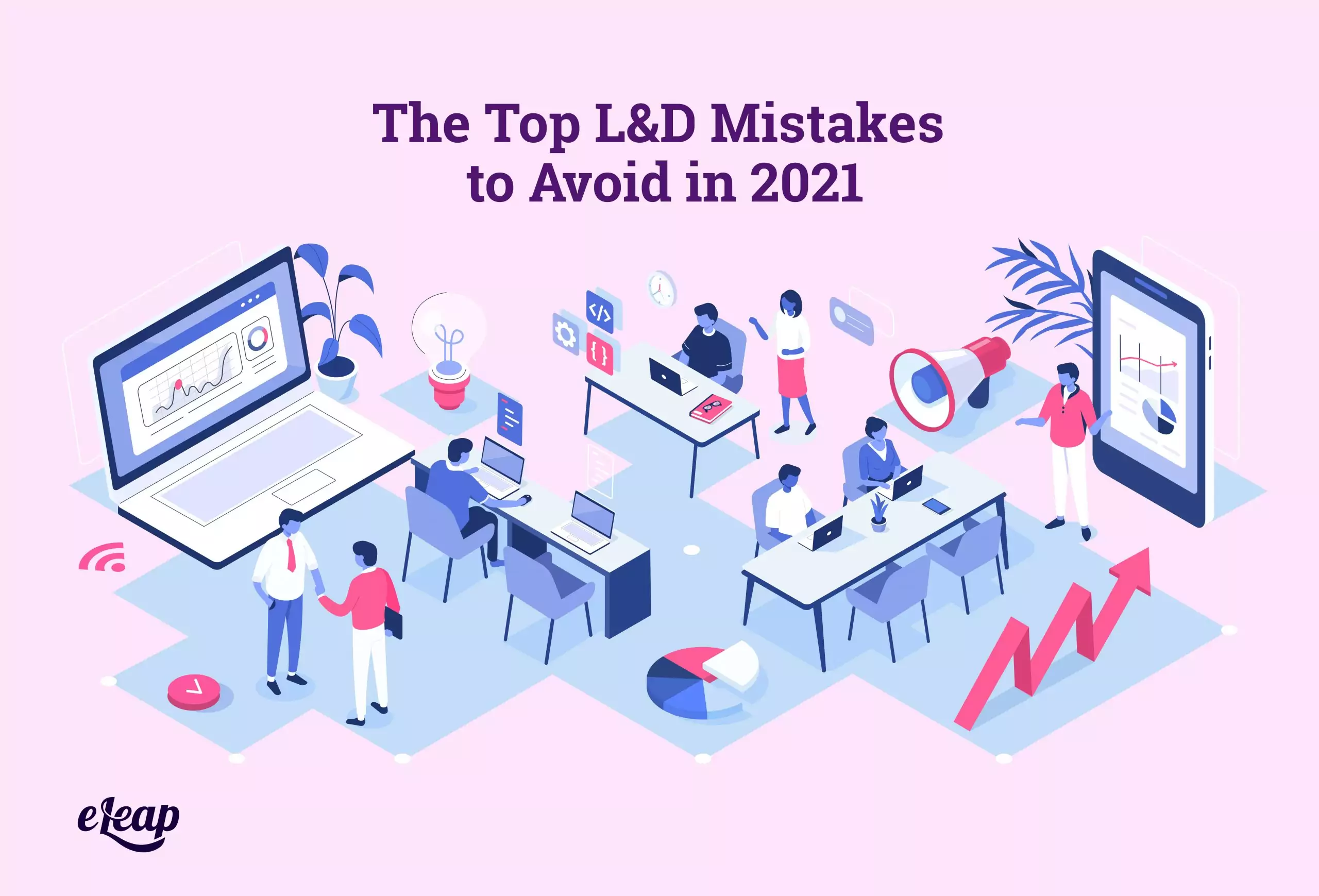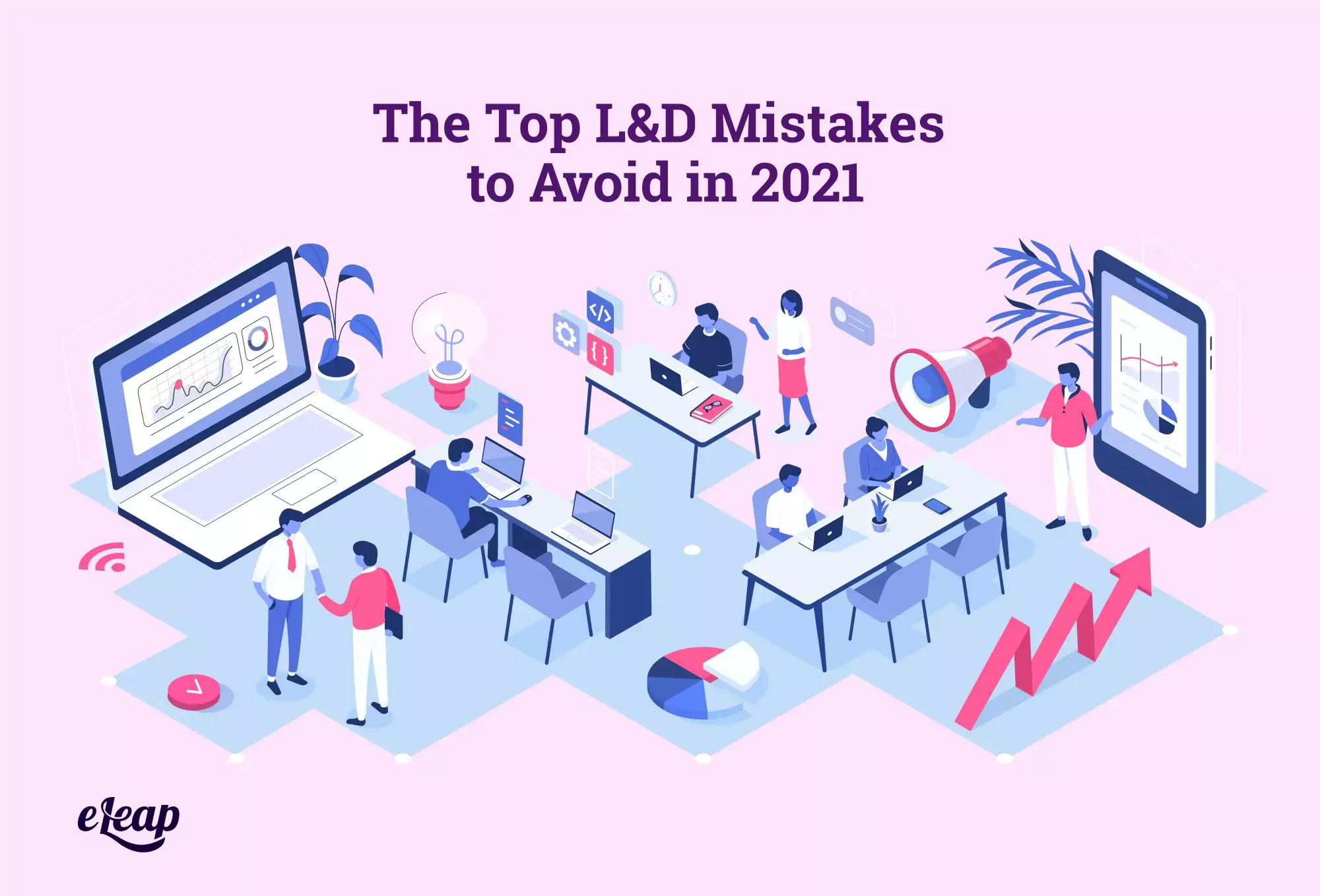The Top L&D Mistakes to Avoid in 2021

Ask any learning and development professional and you’ll get the same answer – L&D can be incredibly challenging to get right. That’s because there are so many missteps and mistakes that can derail your efforts. It’s all too easy to start strong, only to find that your learning and development initiatives completely miss the mark. This article shares the top L&D mistakes one can make and how to avoid or even fix them.
While there are lots of mistakes that can cause problems, the good news is that it’s relatively simple to avoid them if you know the things to look for. In this post, we’ll discuss what you need to know about those mistakes. We’ll also cover crucial tips to avoiding them.

Repercussions of Mistakes in the L&D Process
Before we dive into the actual mistakes to watch for in 2021, we should touch on why vigilance matters. What’s the worst that could happen, really? You’ll find that missteps in your learning and development initiatives can lead to some serious problems, including:
- Reduced employee engagement
- Lowered employee morale
- Damage to the company’s brand
- A reduced ability to compete
- Increased employee turnover
Each of those outcomes is a serious challenge in its own right. When they’re combined? It’s a nightmare quagmire that many companies cannot find their way out of.
The solution? Understand the key mistakes that lead to those outcomes so you can avoid them. By doing so, you help ensure success not just for your initiatives, but for the entire organization.
The Top L&D Mistakes
While the list of potential L&D mistakes is as vast and varied as the list of companies with learning and development initiatives, some missteps top the list. These include the following:
Generic Content
This is perhaps the single most common mistake, and it’s one that crops up from year to year. Generic content is widely available and easy to get your hands on. It’s also, well, generic and often without much in the way of value.
Mass-produced, “boxed content” delivers very little in the way of value. Why is that? Several reasons exist, but one of the most important to understand is that it simply isn’t customized to the individual learner.
Personalization and customization are huge components in today’s business world. However, don’t make the mistake of assuming that customized/personalized learning has anything to do with the learner wanting to feel a closer connection with your organization. It’s really all about how well the content fits their professional life, how it dovetails with their experiences and knowledge, and what it offers them specifically right now, as well as down the road.
Avoid generic content. It’s as simple as that. Your L&D efforts should be customized to each individual to deliver the most value.
Not Conducting a Needs Assessment
You want to develop strong employees, managers, and leaders. However, that often leads to problems. L&D teams try to cram too much into a short time, including coaching, goal setting, how to manage workload, delegation training, problem-solving training, and more.
Here’s the thing – each employee, manager, and leader has different needs. That means each of those types of training has a specific value to each individual. Trying to foist them all on a person at the same time will never yield good results.
Instead, you need to conduct a needs assessment. What skills does the person have? Which ones do they need? What skills will be the most important to their immediate success in a position and which can be moved farther down the learner journey?
By answering these questions, you help ensure that you’re delivering rich, relevant content without overloading anyone, or forcing training that ultimately does the employee little good. It’s also an important part of customization and personalization.
Not Training for Desired Outcomes
Too often, training is provided without much thought for the ultimate outcome. Sure, they’re important skills, but the reason they are important is also critical. For business leaders, that means it is important to provide training based on desired outcomes.
For instance, you want employees to step up and handle certain job tasks, or maybe you need them to achieve specific outcomes that hinge on particular knowledge. You need to create learner journeys that reflect those outcomes. Of course, that’s sometimes easier said than done. In many cases, reverse engineering from the desired outcome backward will help you create a customized learning path.
Taking a Once and Done Stance
One huge mistake is assuming that training programs are going to change employee behavior in the workplace. That might happen in a fraction of instances, but they tend to be the exception that proves the rule. Simply put, you cannot expect a single training program to help employees change performance or behavior-related metrics.
Instead, it’s important to look at training as part of a broader initiative. Define the changes you want to see in an employee (or an entire team or department). Find ways that training can dovetail with those changes, and then create real-world scenarios where learners must use the knowledge they’ve gained from training.
This can be applied to any situation in which performance or behavioral changes are needed, from work processes like customer service to celebrating diversity in the workplace to innovating and thinking outside the box. When you ditch the once-and-done stance, you can begin to see real, permanent change supported by your L&D initiatives.
Not Paying Attention to Soft Skills
Yes, there’s a lot of focus on developing hard skills. However, you cannot overlook the importance of soft skills, particularly for managers and leaders (and anyone who shows promise for those positions and might move into them in the future). Build soft skill development into your L&D initiatives and tie them to other aspects of training, too.
For instance, active listening and problem-solving are critical soft skills for leadership, but they’re also very important in customer service. With a little time and effort, you can tie soft skills to virtually all training, providing your teams with better preparation.
Creating the Best Training for 2021
By avoiding the mistakes we’ve discussed here, you can help ensure maximum value from your L&D initiatives. The right LMS is also a key consideration, and you might need an expert to help create relevant customized content. Whatever your L&D needs, eLeaP can help. Get in touch today to learn more.